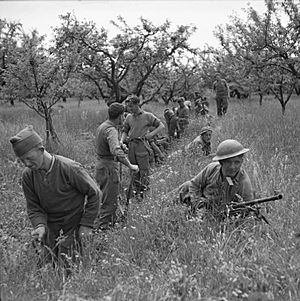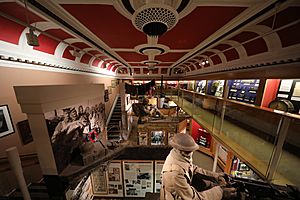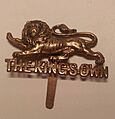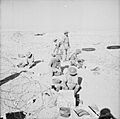King's Own Royal Regiment (Lancaster) facts for kids
The King's Own Royal Regiment (Lancaster) was a famous infantry regiment in the British Army. It served under different names and fought in many wars and conflicts, including both World War I and World War II. The regiment existed from 1680 until 1959.
In 1959, the King's Own Royal Regiment joined with the Border Regiment to form a new unit called the King's Own Royal Border Regiment.
Some of its earlier names were the 2nd Tangier Regiment, Her Royal Highness the Duchess of York and Albany's Regiment of Foot, The Queen's Regiment of Foot, and The King's Own Regiment.
Quick facts for kids 2nd Tangier RegimentThe Duchess of York and Albany's Regiment of Foot The Queen's Regiment of Foot The Earl of Plymouth's Regiment of Foot The 4th (King's Own) Regiment of Foot The King's Own (Royal Lancaster) Regiment The King's Own Royal Regiment (Lancaster) |
|
|---|---|
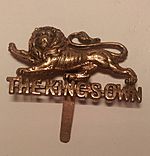
Cap badge of the King's Own Royal Regiment (Lancaster).
|
|
| Active | 1680–1959 |
| Country | |
| Branch | |
| Type | Infantry |
| Role | Line infantry |
| Garrison/HQ | Bowerham Barracks, Lancaster |
| Nickname(s) | Barrell's Blues, The Lions |
| Colours | Blue Facings, Gold Braided Lace |
| March | Quick: Corn Riggs are Bonnie Slow: And Shall Trelawny Die? |
| Engagements | Nine Years' War War of the Spanish Succession Jacobite rising of 1745 Seven Years' War French Revolutionary Wars Peninsular War War of 1812 Napoleonic Wars Crimean War Indian Rebellion of 1857 British Expedition to Abyssinia Anglo-Zulu War Second Boer War First World War Second World War |
Contents
History of the Regiment
How the Regiment Started
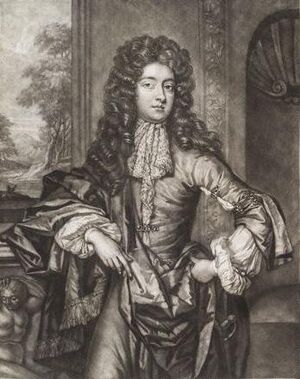
The regiment was officially allowed to start on July 13, 1680. It was founded by the Earl of Plymouth, a son of King Charles II. The plan was to have 1,000 soldiers. Half were recruited in London and half in the West Country.
The regiment was formed to serve in Tangier Garrison, a British outpost in North Africa. It was first known as the 2nd Tangier Regiment. The Earl of Plymouth died soon after arriving in Tangier. Charles Trelawny then became the official colonel in 1682.
Tangier was given up in 1684. When the regiment returned to England, it was renamed Her Royal Highness the Duchess of York and Albany's Regiment of Foot. After James II became king in 1685, its name changed again to The Queen's Regiment of Foot.
Early Battles and Wars
The regiment fought in the Monmouth Rebellion at the Battle of Sedgemoor in July 1685. In November 1688, during the Glorious Revolution, many soldiers joined William III.
From 1690 to 1691, the regiment fought in the Williamite War in Ireland. They were part of the Battle of the Boyne and helped in the sieges of Cork and Limerick. After the war ended in October 1691, they went back to England.
In March 1692, the regiment moved to Flanders (part of modern-day Belgium). They fought in the later parts of the Nine Years' War. They took part in battles like Steenkerque in August 1692 and Landen in July 1693. They also helped in the Siege of Namur in 1695. After the war ended in 1697, the regiment's size was reduced. They were then stationed in Plymouth and Penryn.
The 1700s
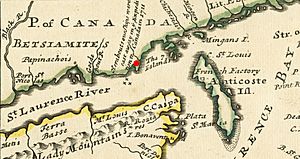
When the War of the Spanish Succession began in 1702, the regiment became a unit of marines. They fought at the Battle of Vigo Bay in October 1702. They also helped capture Gibraltar in August 1704.
In 1711, they became regular infantry again. They joined the Quebec Expedition. This was one of the worst naval disasters in British history. The fleet crashed in thick fog, and over 890 men died. This included 200 soldiers from the regiment.
When George I became king in 1714, the regiment was renamed The Kings Own. For the next 30 years, they were stationed in Scotland and England.
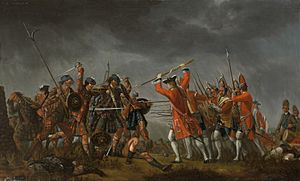
In 1744, they were sent to Flanders during the War of the Austrian Succession. They were in Ghent when the 1745 Jacobite Rising started in Scotland. They were sent to Scotland and fought at the Battle of Falkirk Muir in January 1746.
At the Battle of Culloden in April 1746, the regiment was on the front line. They faced the main attack from the Jacobite army. They had the most casualties on the government side, with 18 dead and 108 wounded. Their commander, Sir Robert Rich, was wounded and lost his left hand. The regiment's flags from this battle are now in the National Museum of Scotland.
After army changes in 1751, the regiment was renamed 4th (King's Own) Regiment of Foot. At the start of the Seven Years' War in 1756, they were in Menorca. They were forced to surrender in June and were sent to Gibraltar. They spent the rest of the war in the West Indies. They helped capture Guadeloupe, Martinique, and Saint Lucia. They returned home in July 1764.
When the American Revolutionary War began in 1774, they were sent to North America. They fought in many battles, including Lexington and Concord, Bunker Hill, and Long Island. In early 1778, they returned to Saint Lucia. They were part of the garrison during the naval battle of St. Lucia in December 1778.
Napoleonic Wars and Beyond
The regiment was sent to Nova Scotia in May 1787. They helped capture Saint Pierre and Miquelon in May 1793. After returning to England, they went to the Netherlands in September 1799. They fought at the Battle of Alkmaar in October 1799.
In August 1808, the regiment went to Portugal for the Napoleonic Wars. They fought at the Battle of Corunna in January 1809. They returned to the Peninsula in October 1810. They fought in the Siege of Badajoz in March 1812, the Battle of Salamanca in July 1812, and the Battle of Vitoria in June 1813. They also helped in the Siege of San Sebastián in September 1813.
They then chased the French Army into France. They saw action at the Battle of the Nivelle in November 1813 and the Battle of the Nive in December 1813. In June 1814, they went to North America for the War of 1812. They fought at the Battle of Bladensburg and the Burning of Washington in August 1814. They also fought at the Battle of Baltimore in September 1814 and the Battle of New Orleans in January 1815. They captured Fort Bowyer in February 1815. They briefly returned to England in May 1815. A few weeks later, they went to Flanders to fight at the Battle of Waterloo in June.
The Victorian Era
From 1832, parts of the regiment guarded convict ships going to Australia. These soldiers were stationed in Sydney, Tasmania, Victoria, South Australia, and Swan River. The regiment left Australia in 1837 and went to India.
During the Crimean War, the regiment fought at the Battle of Alma in September 1854 and the Battle of Inkerman in November 1854. They also took part in the Siege of Sevastopol in the winter of 1854. They also saw action in Abyssinia in 1868 and South Africa in 1879.
In 1881, the regiment was renamed the King's Own (Royal Lancaster Regiment). This was part of army changes that gave them a base at Bowerham Barracks in Lancaster. The regiment already had two battalions, so it did not need to combine with another regiment.
The 2nd Battalion went to South Africa in December 1899 for the Second Boer War. They fought at the Battle of Spion Kop in January 1900. Other battalions also went to South Africa.
In 1908, army volunteers and militia were reorganized. The regiment then had one Reserve and two Territorial battalions.
First World War Service
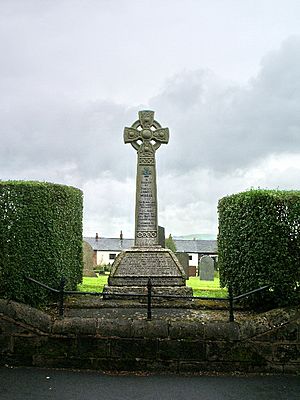
During the First World War, the regiment created 14 new battalions.
Regular Army Battalions
The 1st Battalion arrived in France in August 1914. It was almost destroyed at the Battle of Le Cateau on August 26, 1914. They lost about 400 soldiers in just two minutes from machine gun fire. They served on the Western Front for the rest of the war.
The 2nd Battalion returned from India in December 1914. They arrived in France in January 1915. They suffered heavy losses at the Battle of Frezenberg in May 1915. Later, they moved to Egypt and then to Salonika.
Reserve and Territorial Battalions
The 3rd (Reserve) Battalion stayed in the United Kingdom. It trained new soldiers and sent them as replacements to the battalions fighting overseas.
Several Territorial battalions, like the 1/4th and 1/5th, also served in France. They were part of different divisions and brigades. Some battalions were formed as "duplicates" to provide more soldiers.
Kitchener's Army Battalions
Many new battalions were formed as part of "Kitchener's Army." These were volunteer soldiers who joined up at the start of the war.
- The 6th (Service) Battalion fought at Gallipoli in July 1915 and later in Mesopotamia.
- The 7th (Service) Battalion fought in France from July 1915.
- The 8th (Service) Battalion fought on the Western Front. They helped slow down the German advance at the Battle of St. Quentin in March 1918.
- The 9th (Service) Battalion served in Salonika.
- The 11th (Service) Battalion was a "Bantam" battalion, meaning it was made up of smaller men. It fought in France from June 1916.
Between the World Wars
In 1921, the regiment was officially renamed the King's Own Royal Regiment (Lancaster).
Second World War Service
The regiment had several battalions serving during the Second World War.
Regular Army Battalions
The 1st Battalion was in Malta when the war began. It later moved to Karachi in British India. It served in Iraq and Syria. In October 1943, most of the battalion was captured by the Germans after the Battle of Leros. The battalion was reformed in January 1944. It then served in the Italian Campaign for the rest of the war.
The 2nd Battalion was in Jerusalem when the war started. It later moved to Egypt. The battalion helped defend Tobruk. In September 1943, it was chosen to join the Chindits in the Burma Campaign. The Chindits were special forces who went deep behind enemy lines. The battalion crossed into Burma in March 1944.
Territorial Army Battalions
The 4th Battalion became an artillery unit in November 1938. It was called the 56th (King's Own) Anti-Tank Regiment, Royal Artillery. It fought in the Battle of France in May 1940 and was evacuated from Dunkirk. It later served in the Burma Campaign.
The 5th Battalion fought with the British Expeditionary Force in France and Belgium in 1940. When its division became an armoured (tank) division, the 5th Battalion became a tank unit called the 107th Regiment Royal Armoured Corps.
Hostilities-Only Battalions
The 6th, 7th, 8th, and 9th Battalions were formed specifically for the war. They served as "pioneer" battalions, doing important support work. All four units served in France and Belgium in 1940.
The 6th Battalion never served overseas again and was disbanded in July 1944. The 7th Battalion went to Gibraltar and later to India. The 8th Battalion joined the Malta garrison in August 1941 and served through the Siege. It later went to Italy, where it combined with the reformed 1st Battalion. The 9th Battalion became an artillery unit.
The 10th Battalion was formed in May 1940. It later became the 151st Regiment Royal Armoured Corps, a tank unit. This unit later took the number 107th to continue the history of the 5th Battalion. The new 107th Regiment served in North-west Europe from 1944-1945.
After the Wars
After World War II, most of the wartime units were disbanded. The 2nd Battalion was also disbanded in 1948.
In 1953, the regiment was given the freedom of Lancaster. From 1953 to 1954, the 1st Battalion was stationed in South Korea after the Korean War.
On October 31, 1959, the King's Own Royal Regiment joined with the Border Regiment to become the King's Own Royal Border Regiment.
Regimental Museum
The King's Own Royal Regiment Museum is part of the Lancaster City Museum in Lancaster, Lancashire. The museum opened in 1929. It displays uniforms, medals, flags, paintings, weapons, and other items that show the regiment's long history.
Victoria Cross Heroes
The Victoria Cross is the highest award for bravery in the British military. The following members of the regiment earned this award:
- Private (later Sergeant) Thomas Grady, during the Crimean War
- Private Albert Halton, 1st Battalion, First World War
- Private Harry Christian, 2nd Battalion, First World War
- Lance-Sergeant Tom Fletcher Mayson, 1/4th Battalion, First World War
- Second Lieutenant Joseph Henry Collin, 1/4th Battalion, First World War
- Lance-Corporal (later Corporal) James Hewitson, 1/4th Battalion, First World War
- Lance-Corporal Jack White, 6th (Service) Battalion, First World War
- Private James Miller, 7th (Service) Battalion, First World War
- Corporal Thomas Neely, 8th (Service) Battalion, First World War
Images for kids
-
The founder of the regiment, Charles Fitzcharles, Earl of Plymouth, who was a son of King Charles II.
-
Over 200 members of the regiment died during the 1711 Quebec Expedition. The red mark shows where the ships wrecked.
-
A painting showing soldiers of the regiment fighting at the Battle of Culloden in April 1746.
-
Memorial to Private James Miller VC, a brave soldier who died during the First World War.



